Analysis of Applied Ethics and Sustainability: Ecological Footprint
VerifiedAdded on 2023/03/20
|9
|2252
|72
Report
AI Summary
This report presents a comprehensive analysis of a student's ecological footprint, calculated using the WWF calculator, and explores the implications of their consumption patterns. The analysis begins with an explanation of the ecological footprint and carbon footprint, referencing relevant benchmarks like carbon sequestration rates of forests. The report then interprets the key results by land type and consumption category, identifying four major causes of unsustainable aspects of the student's personal lifestyle, such as high mobility and consumption habits. It proposes potential solutions within the categories of City, Energy, Food, and Population. The report further examines the sustainability of a chosen product, Alba edible cooking oil, analyzing its production process, environmental impact, and stakeholder expectations. It suggests improvements, like eco-friendly packaging and incorporating cradle-to-cradle model. The report concludes by discussing the product's non-substitutability and highlighting the company's efforts towards sustainability.
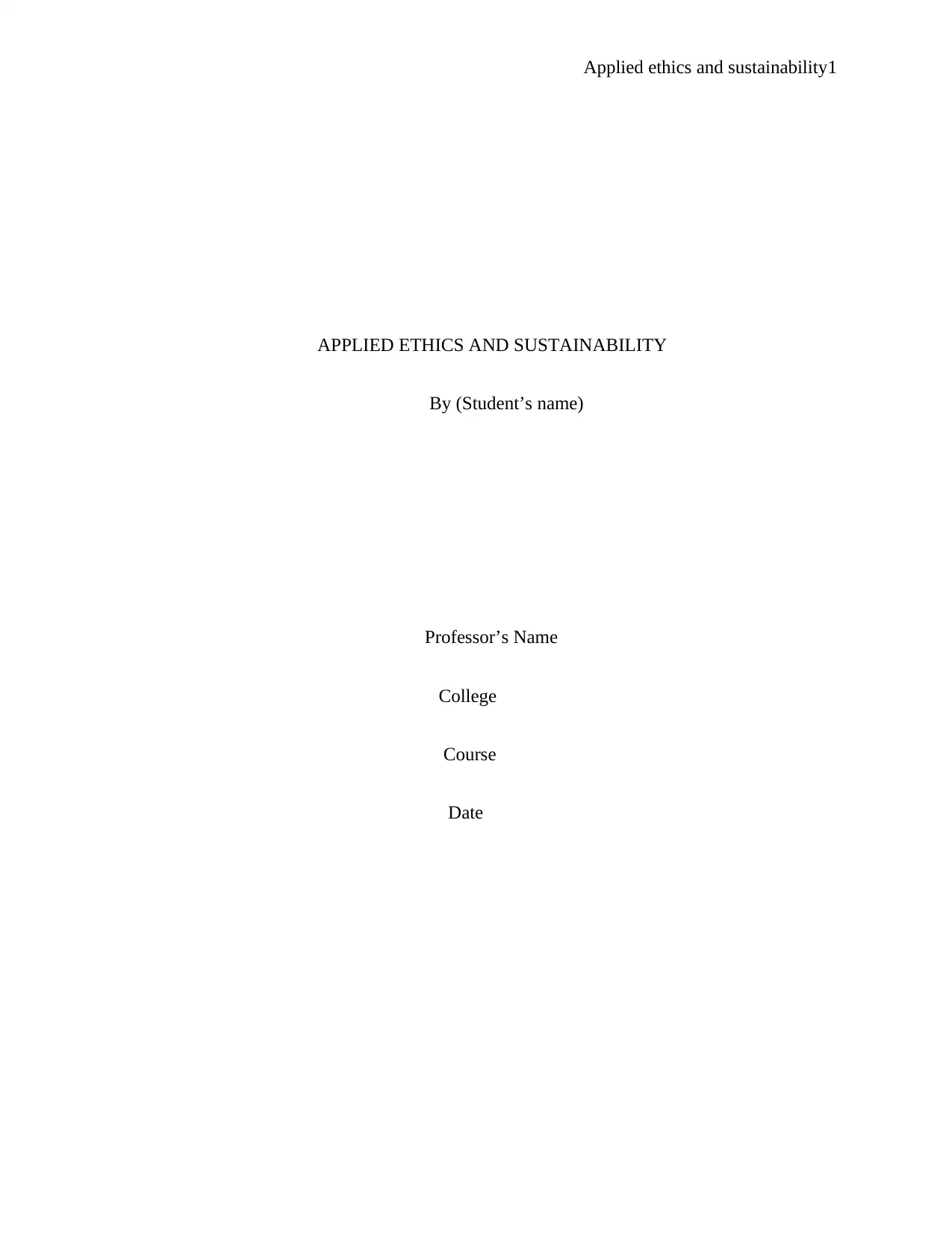
Applied ethics and sustainability1
APPLIED ETHICS AND SUSTAINABILITY
By (Student’s name)
Professor’s Name
College
Course
Date
APPLIED ETHICS AND SUSTAINABILITY
By (Student’s name)
Professor’s Name
College
Course
Date
Paraphrase This Document
Need a fresh take? Get an instant paraphrase of this document with our AI Paraphraser
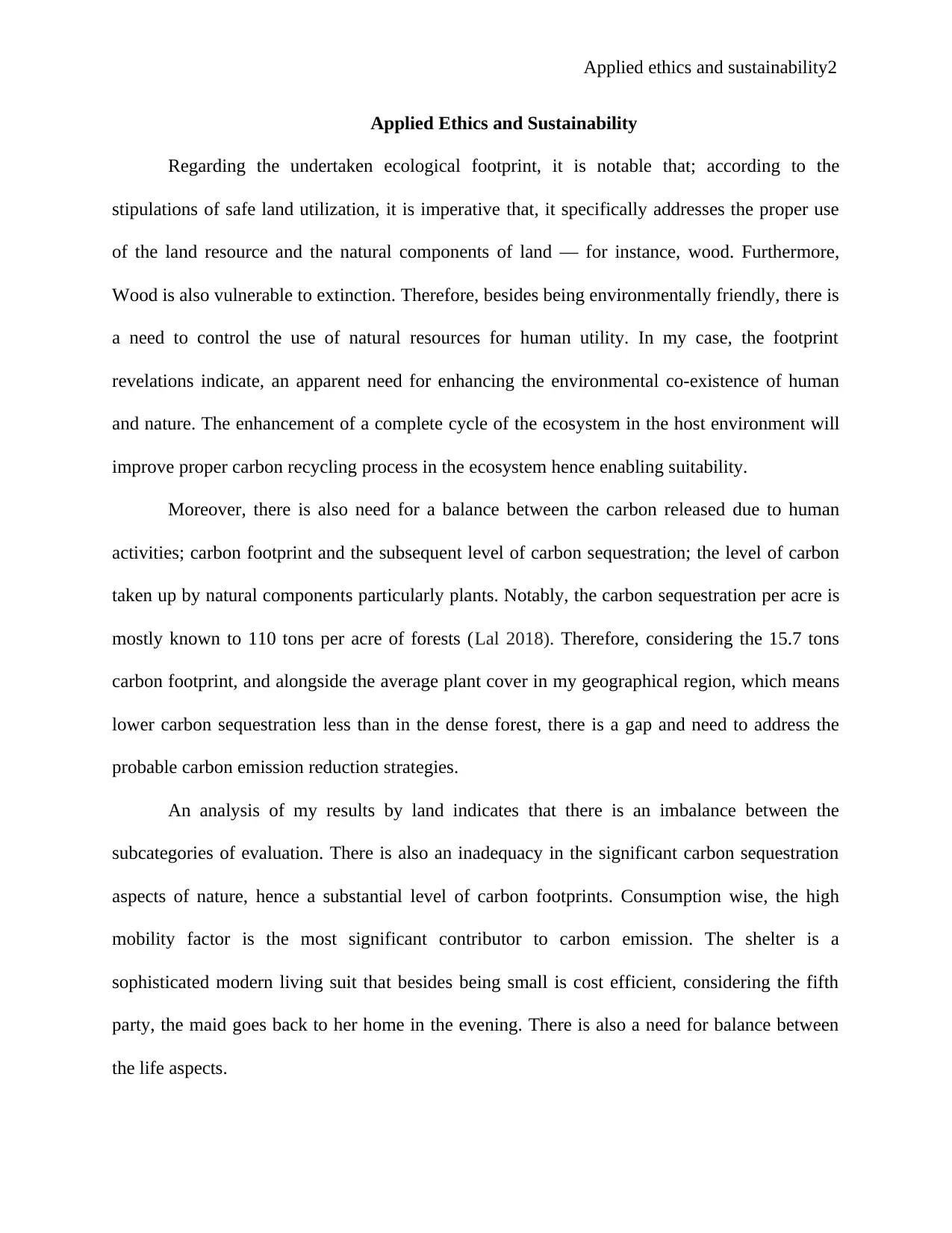
Applied ethics and sustainability2
Applied Ethics and Sustainability
Regarding the undertaken ecological footprint, it is notable that; according to the
stipulations of safe land utilization, it is imperative that, it specifically addresses the proper use
of the land resource and the natural components of land — for instance, wood. Furthermore,
Wood is also vulnerable to extinction. Therefore, besides being environmentally friendly, there is
a need to control the use of natural resources for human utility. In my case, the footprint
revelations indicate, an apparent need for enhancing the environmental co-existence of human
and nature. The enhancement of a complete cycle of the ecosystem in the host environment will
improve proper carbon recycling process in the ecosystem hence enabling suitability.
Moreover, there is also need for a balance between the carbon released due to human
activities; carbon footprint and the subsequent level of carbon sequestration; the level of carbon
taken up by natural components particularly plants. Notably, the carbon sequestration per acre is
mostly known to 110 tons per acre of forests (Lal 2018). Therefore, considering the 15.7 tons
carbon footprint, and alongside the average plant cover in my geographical region, which means
lower carbon sequestration less than in the dense forest, there is a gap and need to address the
probable carbon emission reduction strategies.
An analysis of my results by land indicates that there is an imbalance between the
subcategories of evaluation. There is also an inadequacy in the significant carbon sequestration
aspects of nature, hence a substantial level of carbon footprints. Consumption wise, the high
mobility factor is the most significant contributor to carbon emission. The shelter is a
sophisticated modern living suit that besides being small is cost efficient, considering the fifth
party, the maid goes back to her home in the evening. There is also a need for balance between
the life aspects.
Applied Ethics and Sustainability
Regarding the undertaken ecological footprint, it is notable that; according to the
stipulations of safe land utilization, it is imperative that, it specifically addresses the proper use
of the land resource and the natural components of land — for instance, wood. Furthermore,
Wood is also vulnerable to extinction. Therefore, besides being environmentally friendly, there is
a need to control the use of natural resources for human utility. In my case, the footprint
revelations indicate, an apparent need for enhancing the environmental co-existence of human
and nature. The enhancement of a complete cycle of the ecosystem in the host environment will
improve proper carbon recycling process in the ecosystem hence enabling suitability.
Moreover, there is also need for a balance between the carbon released due to human
activities; carbon footprint and the subsequent level of carbon sequestration; the level of carbon
taken up by natural components particularly plants. Notably, the carbon sequestration per acre is
mostly known to 110 tons per acre of forests (Lal 2018). Therefore, considering the 15.7 tons
carbon footprint, and alongside the average plant cover in my geographical region, which means
lower carbon sequestration less than in the dense forest, there is a gap and need to address the
probable carbon emission reduction strategies.
An analysis of my results by land indicates that there is an imbalance between the
subcategories of evaluation. There is also an inadequacy in the significant carbon sequestration
aspects of nature, hence a substantial level of carbon footprints. Consumption wise, the high
mobility factor is the most significant contributor to carbon emission. The shelter is a
sophisticated modern living suit that besides being small is cost efficient, considering the fifth
party, the maid goes back to her home in the evening. There is also a need for balance between
the life aspects.
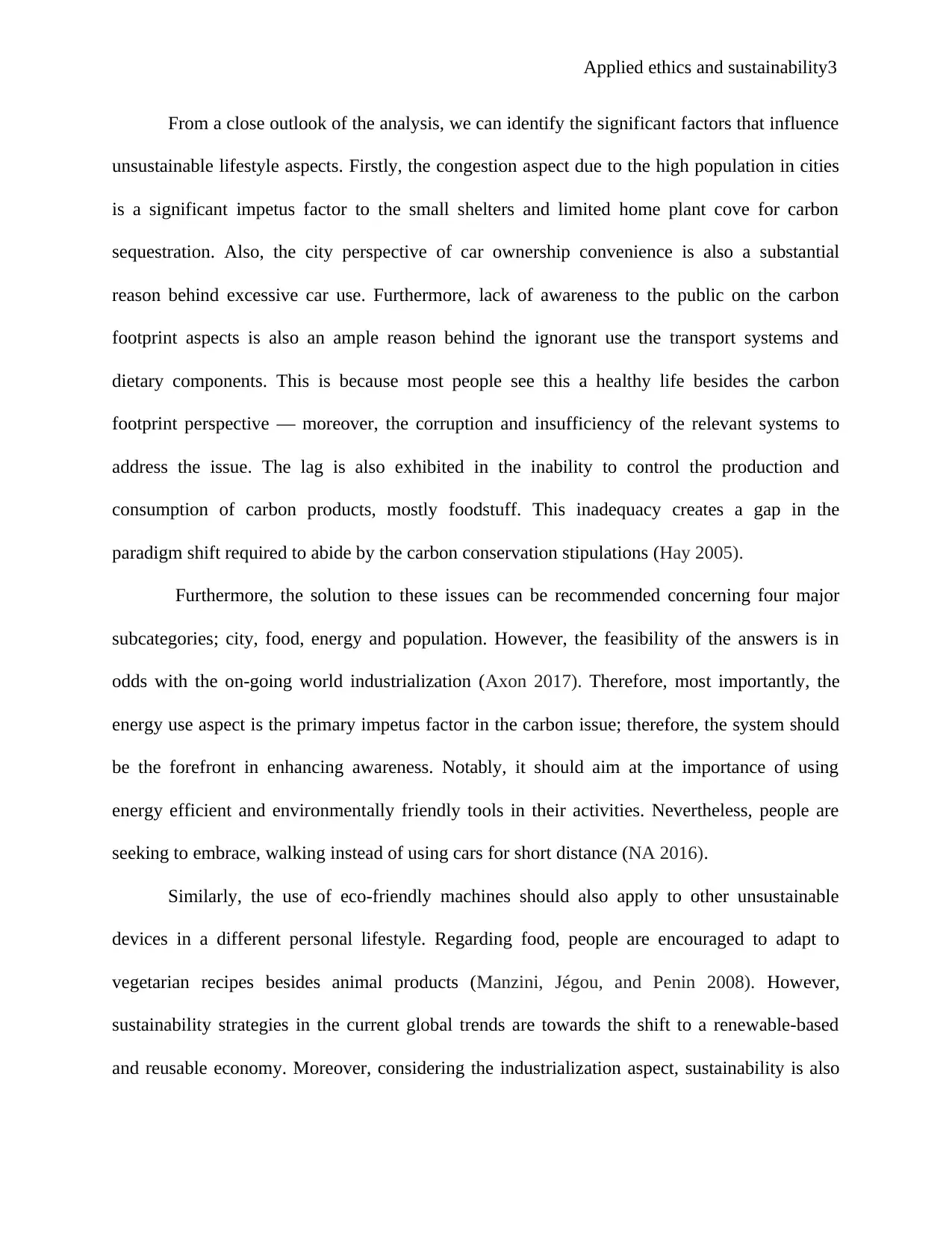
Applied ethics and sustainability3
From a close outlook of the analysis, we can identify the significant factors that influence
unsustainable lifestyle aspects. Firstly, the congestion aspect due to the high population in cities
is a significant impetus factor to the small shelters and limited home plant cove for carbon
sequestration. Also, the city perspective of car ownership convenience is also a substantial
reason behind excessive car use. Furthermore, lack of awareness to the public on the carbon
footprint aspects is also an ample reason behind the ignorant use the transport systems and
dietary components. This is because most people see this a healthy life besides the carbon
footprint perspective — moreover, the corruption and insufficiency of the relevant systems to
address the issue. The lag is also exhibited in the inability to control the production and
consumption of carbon products, mostly foodstuff. This inadequacy creates a gap in the
paradigm shift required to abide by the carbon conservation stipulations (Hay 2005).
Furthermore, the solution to these issues can be recommended concerning four major
subcategories; city, food, energy and population. However, the feasibility of the answers is in
odds with the on-going world industrialization (Axon 2017). Therefore, most importantly, the
energy use aspect is the primary impetus factor in the carbon issue; therefore, the system should
be the forefront in enhancing awareness. Notably, it should aim at the importance of using
energy efficient and environmentally friendly tools in their activities. Nevertheless, people are
seeking to embrace, walking instead of using cars for short distance (NA 2016).
Similarly, the use of eco-friendly machines should also apply to other unsustainable
devices in a different personal lifestyle. Regarding food, people are encouraged to adapt to
vegetarian recipes besides animal products (Manzini, Jégou, and Penin 2008). However,
sustainability strategies in the current global trends are towards the shift to a renewable-based
and reusable economy. Moreover, considering the industrialization aspect, sustainability is also
From a close outlook of the analysis, we can identify the significant factors that influence
unsustainable lifestyle aspects. Firstly, the congestion aspect due to the high population in cities
is a significant impetus factor to the small shelters and limited home plant cove for carbon
sequestration. Also, the city perspective of car ownership convenience is also a substantial
reason behind excessive car use. Furthermore, lack of awareness to the public on the carbon
footprint aspects is also an ample reason behind the ignorant use the transport systems and
dietary components. This is because most people see this a healthy life besides the carbon
footprint perspective — moreover, the corruption and insufficiency of the relevant systems to
address the issue. The lag is also exhibited in the inability to control the production and
consumption of carbon products, mostly foodstuff. This inadequacy creates a gap in the
paradigm shift required to abide by the carbon conservation stipulations (Hay 2005).
Furthermore, the solution to these issues can be recommended concerning four major
subcategories; city, food, energy and population. However, the feasibility of the answers is in
odds with the on-going world industrialization (Axon 2017). Therefore, most importantly, the
energy use aspect is the primary impetus factor in the carbon issue; therefore, the system should
be the forefront in enhancing awareness. Notably, it should aim at the importance of using
energy efficient and environmentally friendly tools in their activities. Nevertheless, people are
seeking to embrace, walking instead of using cars for short distance (NA 2016).
Similarly, the use of eco-friendly machines should also apply to other unsustainable
devices in a different personal lifestyle. Regarding food, people are encouraged to adapt to
vegetarian recipes besides animal products (Manzini, Jégou, and Penin 2008). However,
sustainability strategies in the current global trends are towards the shift to a renewable-based
and reusable economy. Moreover, considering the industrialization aspect, sustainability is also
⊘ This is a preview!⊘
Do you want full access?
Subscribe today to unlock all pages.

Trusted by 1+ million students worldwide
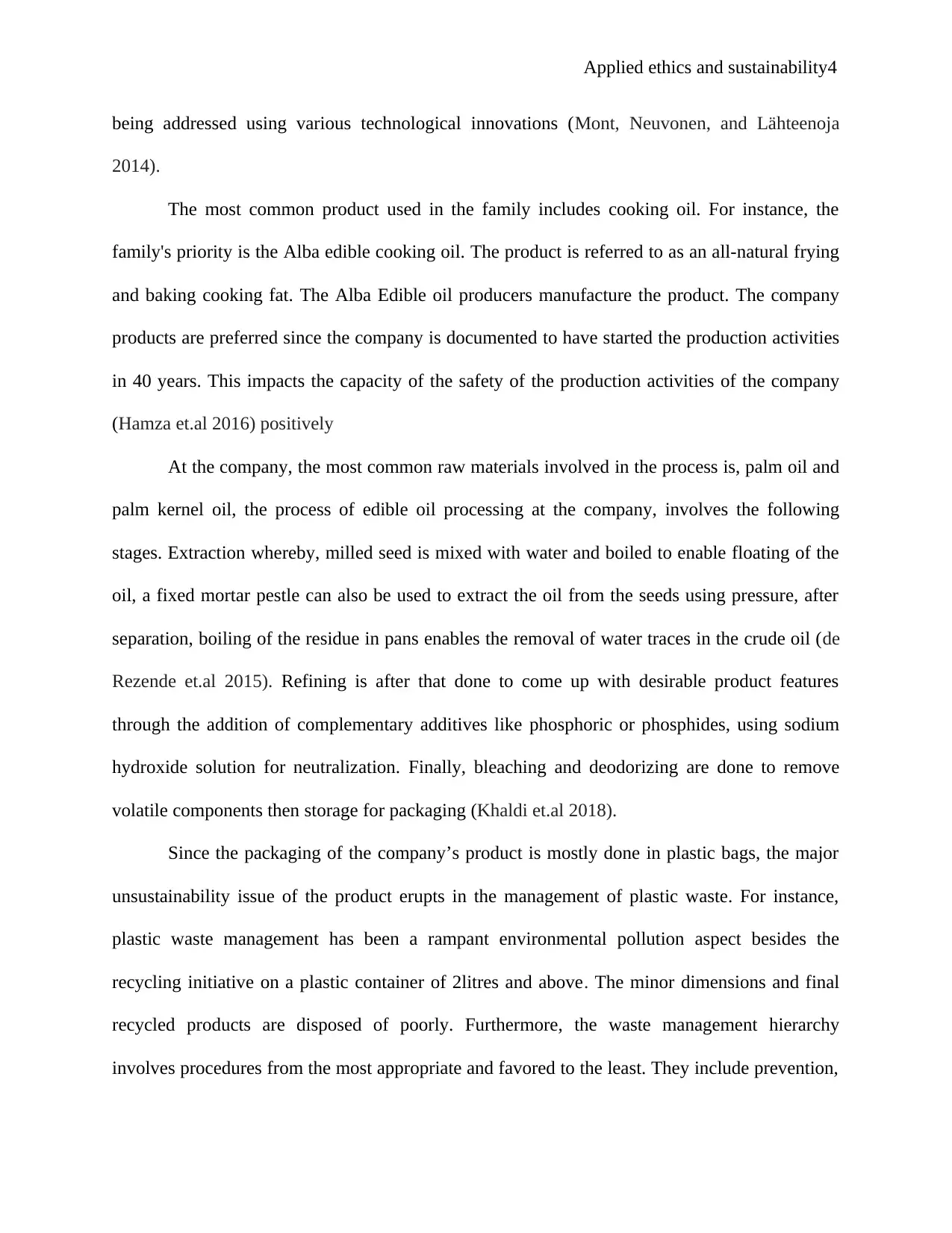
Applied ethics and sustainability4
being addressed using various technological innovations (Mont, Neuvonen, and Lähteenoja
2014).
The most common product used in the family includes cooking oil. For instance, the
family's priority is the Alba edible cooking oil. The product is referred to as an all-natural frying
and baking cooking fat. The Alba Edible oil producers manufacture the product. The company
products are preferred since the company is documented to have started the production activities
in 40 years. This impacts the capacity of the safety of the production activities of the company
(Hamza et.al 2016) positively
At the company, the most common raw materials involved in the process is, palm oil and
palm kernel oil, the process of edible oil processing at the company, involves the following
stages. Extraction whereby, milled seed is mixed with water and boiled to enable floating of the
oil, a fixed mortar pestle can also be used to extract the oil from the seeds using pressure, after
separation, boiling of the residue in pans enables the removal of water traces in the crude oil (de
Rezende et.al 2015). Refining is after that done to come up with desirable product features
through the addition of complementary additives like phosphoric or phosphides, using sodium
hydroxide solution for neutralization. Finally, bleaching and deodorizing are done to remove
volatile components then storage for packaging (Khaldi et.al 2018).
Since the packaging of the company’s product is mostly done in plastic bags, the major
unsustainability issue of the product erupts in the management of plastic waste. For instance,
plastic waste management has been a rampant environmental pollution aspect besides the
recycling initiative on a plastic container of 2litres and above. The minor dimensions and final
recycled products are disposed of poorly. Furthermore, the waste management hierarchy
involves procedures from the most appropriate and favored to the least. They include prevention,
being addressed using various technological innovations (Mont, Neuvonen, and Lähteenoja
2014).
The most common product used in the family includes cooking oil. For instance, the
family's priority is the Alba edible cooking oil. The product is referred to as an all-natural frying
and baking cooking fat. The Alba Edible oil producers manufacture the product. The company
products are preferred since the company is documented to have started the production activities
in 40 years. This impacts the capacity of the safety of the production activities of the company
(Hamza et.al 2016) positively
At the company, the most common raw materials involved in the process is, palm oil and
palm kernel oil, the process of edible oil processing at the company, involves the following
stages. Extraction whereby, milled seed is mixed with water and boiled to enable floating of the
oil, a fixed mortar pestle can also be used to extract the oil from the seeds using pressure, after
separation, boiling of the residue in pans enables the removal of water traces in the crude oil (de
Rezende et.al 2015). Refining is after that done to come up with desirable product features
through the addition of complementary additives like phosphoric or phosphides, using sodium
hydroxide solution for neutralization. Finally, bleaching and deodorizing are done to remove
volatile components then storage for packaging (Khaldi et.al 2018).
Since the packaging of the company’s product is mostly done in plastic bags, the major
unsustainability issue of the product erupts in the management of plastic waste. For instance,
plastic waste management has been a rampant environmental pollution aspect besides the
recycling initiative on a plastic container of 2litres and above. The minor dimensions and final
recycled products are disposed of poorly. Furthermore, the waste management hierarchy
involves procedures from the most appropriate and favored to the least. They include prevention,
Paraphrase This Document
Need a fresh take? Get an instant paraphrase of this document with our AI Paraphraser
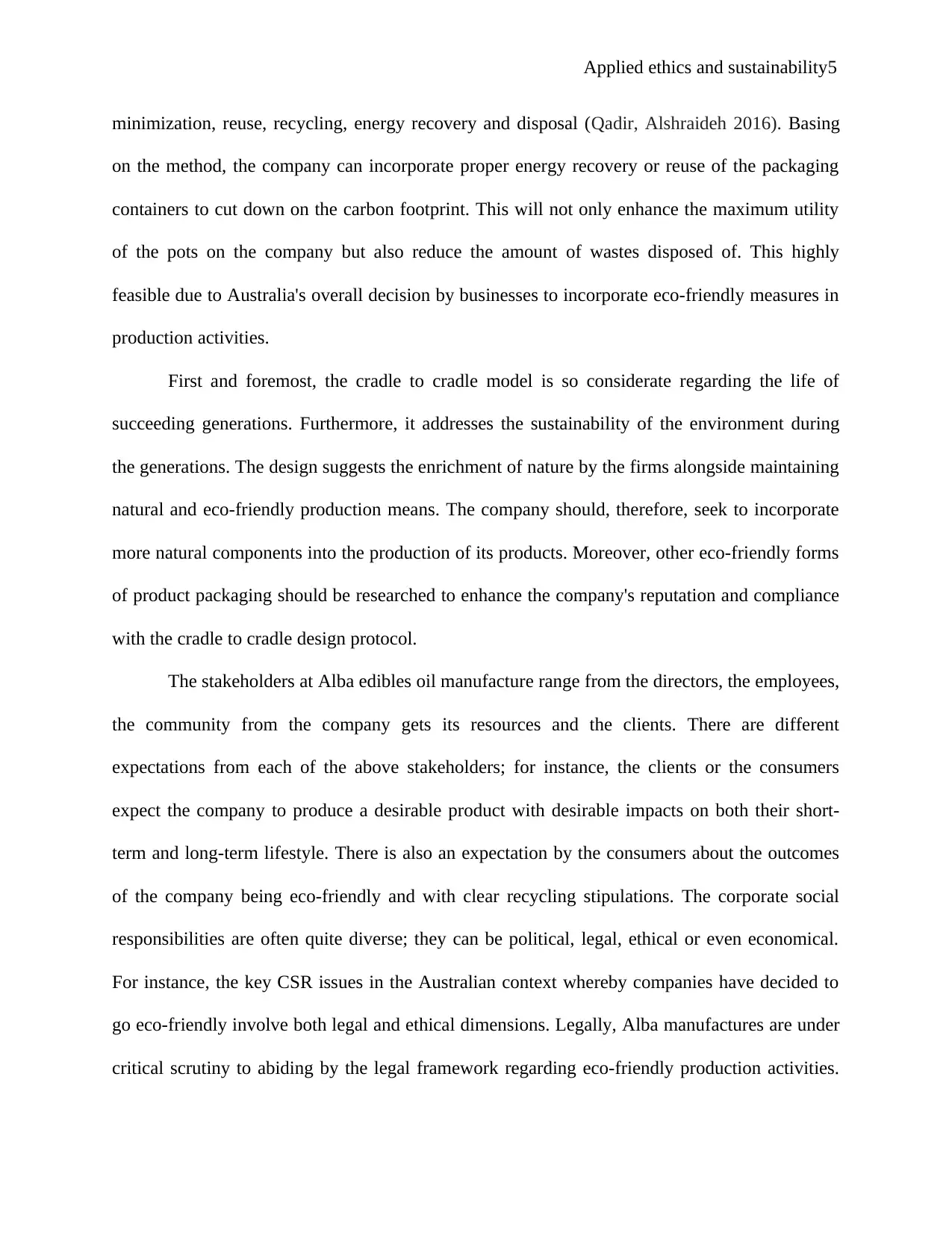
Applied ethics and sustainability5
minimization, reuse, recycling, energy recovery and disposal (Qadir, Alshraideh 2016). Basing
on the method, the company can incorporate proper energy recovery or reuse of the packaging
containers to cut down on the carbon footprint. This will not only enhance the maximum utility
of the pots on the company but also reduce the amount of wastes disposed of. This highly
feasible due to Australia's overall decision by businesses to incorporate eco-friendly measures in
production activities.
First and foremost, the cradle to cradle model is so considerate regarding the life of
succeeding generations. Furthermore, it addresses the sustainability of the environment during
the generations. The design suggests the enrichment of nature by the firms alongside maintaining
natural and eco-friendly production means. The company should, therefore, seek to incorporate
more natural components into the production of its products. Moreover, other eco-friendly forms
of product packaging should be researched to enhance the company's reputation and compliance
with the cradle to cradle design protocol.
The stakeholders at Alba edibles oil manufacture range from the directors, the employees,
the community from the company gets its resources and the clients. There are different
expectations from each of the above stakeholders; for instance, the clients or the consumers
expect the company to produce a desirable product with desirable impacts on both their short-
term and long-term lifestyle. There is also an expectation by the consumers about the outcomes
of the company being eco-friendly and with clear recycling stipulations. The corporate social
responsibilities are often quite diverse; they can be political, legal, ethical or even economical.
For instance, the key CSR issues in the Australian context whereby companies have decided to
go eco-friendly involve both legal and ethical dimensions. Legally, Alba manufactures are under
critical scrutiny to abiding by the legal framework regarding eco-friendly production activities.
minimization, reuse, recycling, energy recovery and disposal (Qadir, Alshraideh 2016). Basing
on the method, the company can incorporate proper energy recovery or reuse of the packaging
containers to cut down on the carbon footprint. This will not only enhance the maximum utility
of the pots on the company but also reduce the amount of wastes disposed of. This highly
feasible due to Australia's overall decision by businesses to incorporate eco-friendly measures in
production activities.
First and foremost, the cradle to cradle model is so considerate regarding the life of
succeeding generations. Furthermore, it addresses the sustainability of the environment during
the generations. The design suggests the enrichment of nature by the firms alongside maintaining
natural and eco-friendly production means. The company should, therefore, seek to incorporate
more natural components into the production of its products. Moreover, other eco-friendly forms
of product packaging should be researched to enhance the company's reputation and compliance
with the cradle to cradle design protocol.
The stakeholders at Alba edibles oil manufacture range from the directors, the employees,
the community from the company gets its resources and the clients. There are different
expectations from each of the above stakeholders; for instance, the clients or the consumers
expect the company to produce a desirable product with desirable impacts on both their short-
term and long-term lifestyle. There is also an expectation by the consumers about the outcomes
of the company being eco-friendly and with clear recycling stipulations. The corporate social
responsibilities are often quite diverse; they can be political, legal, ethical or even economical.
For instance, the key CSR issues in the Australian context whereby companies have decided to
go eco-friendly involve both legal and ethical dimensions. Legally, Alba manufactures are under
critical scrutiny to abiding by the legal framework regarding eco-friendly production activities.
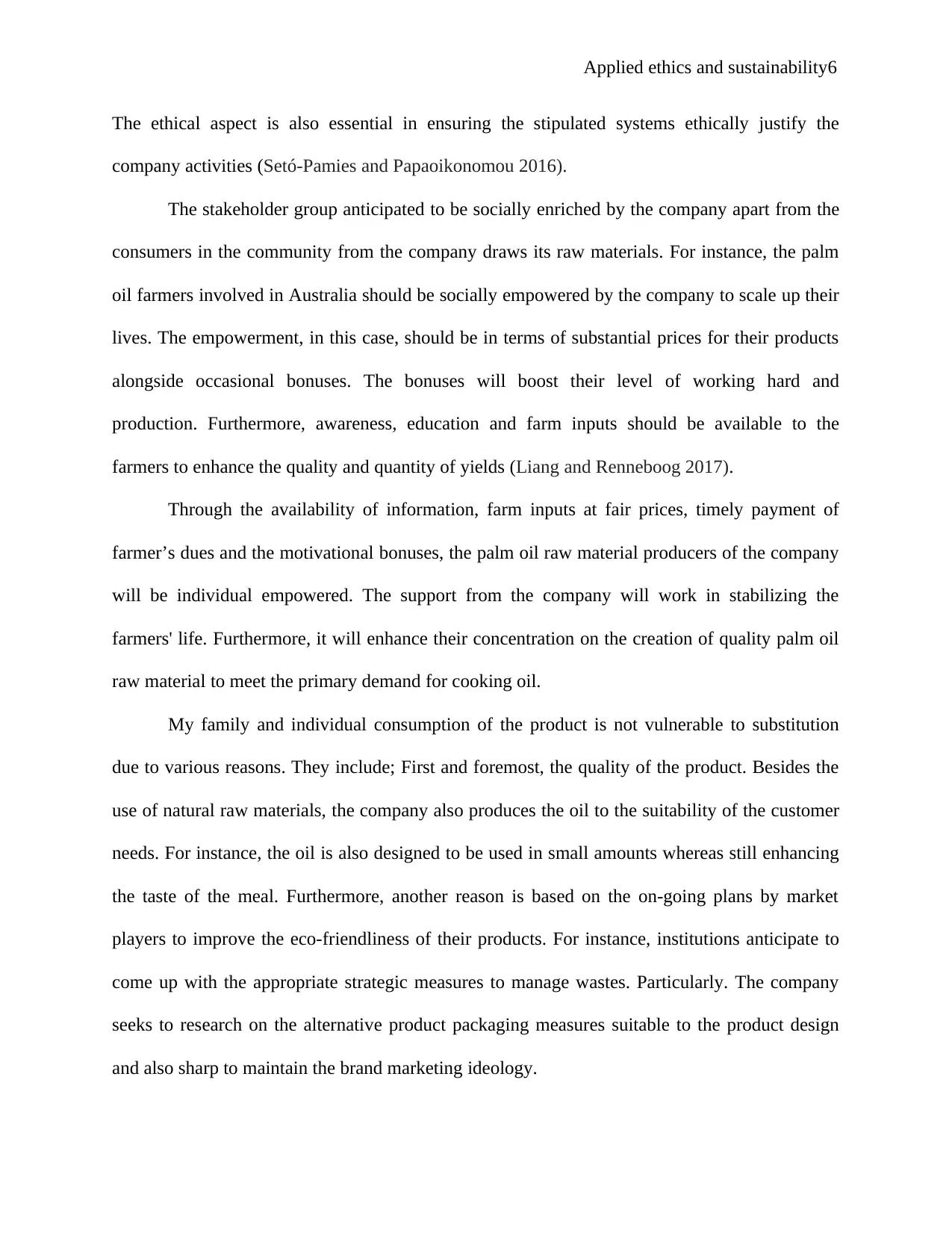
Applied ethics and sustainability6
The ethical aspect is also essential in ensuring the stipulated systems ethically justify the
company activities (Setó-Pamies and Papaoikonomou 2016).
The stakeholder group anticipated to be socially enriched by the company apart from the
consumers in the community from the company draws its raw materials. For instance, the palm
oil farmers involved in Australia should be socially empowered by the company to scale up their
lives. The empowerment, in this case, should be in terms of substantial prices for their products
alongside occasional bonuses. The bonuses will boost their level of working hard and
production. Furthermore, awareness, education and farm inputs should be available to the
farmers to enhance the quality and quantity of yields (Liang and Renneboog 2017).
Through the availability of information, farm inputs at fair prices, timely payment of
farmer’s dues and the motivational bonuses, the palm oil raw material producers of the company
will be individual empowered. The support from the company will work in stabilizing the
farmers' life. Furthermore, it will enhance their concentration on the creation of quality palm oil
raw material to meet the primary demand for cooking oil.
My family and individual consumption of the product is not vulnerable to substitution
due to various reasons. They include; First and foremost, the quality of the product. Besides the
use of natural raw materials, the company also produces the oil to the suitability of the customer
needs. For instance, the oil is also designed to be used in small amounts whereas still enhancing
the taste of the meal. Furthermore, another reason is based on the on-going plans by market
players to improve the eco-friendliness of their products. For instance, institutions anticipate to
come up with the appropriate strategic measures to manage wastes. Particularly. The company
seeks to research on the alternative product packaging measures suitable to the product design
and also sharp to maintain the brand marketing ideology.
The ethical aspect is also essential in ensuring the stipulated systems ethically justify the
company activities (Setó-Pamies and Papaoikonomou 2016).
The stakeholder group anticipated to be socially enriched by the company apart from the
consumers in the community from the company draws its raw materials. For instance, the palm
oil farmers involved in Australia should be socially empowered by the company to scale up their
lives. The empowerment, in this case, should be in terms of substantial prices for their products
alongside occasional bonuses. The bonuses will boost their level of working hard and
production. Furthermore, awareness, education and farm inputs should be available to the
farmers to enhance the quality and quantity of yields (Liang and Renneboog 2017).
Through the availability of information, farm inputs at fair prices, timely payment of
farmer’s dues and the motivational bonuses, the palm oil raw material producers of the company
will be individual empowered. The support from the company will work in stabilizing the
farmers' life. Furthermore, it will enhance their concentration on the creation of quality palm oil
raw material to meet the primary demand for cooking oil.
My family and individual consumption of the product is not vulnerable to substitution
due to various reasons. They include; First and foremost, the quality of the product. Besides the
use of natural raw materials, the company also produces the oil to the suitability of the customer
needs. For instance, the oil is also designed to be used in small amounts whereas still enhancing
the taste of the meal. Furthermore, another reason is based on the on-going plans by market
players to improve the eco-friendliness of their products. For instance, institutions anticipate to
come up with the appropriate strategic measures to manage wastes. Particularly. The company
seeks to research on the alternative product packaging measures suitable to the product design
and also sharp to maintain the brand marketing ideology.
⊘ This is a preview!⊘
Do you want full access?
Subscribe today to unlock all pages.

Trusted by 1+ million students worldwide
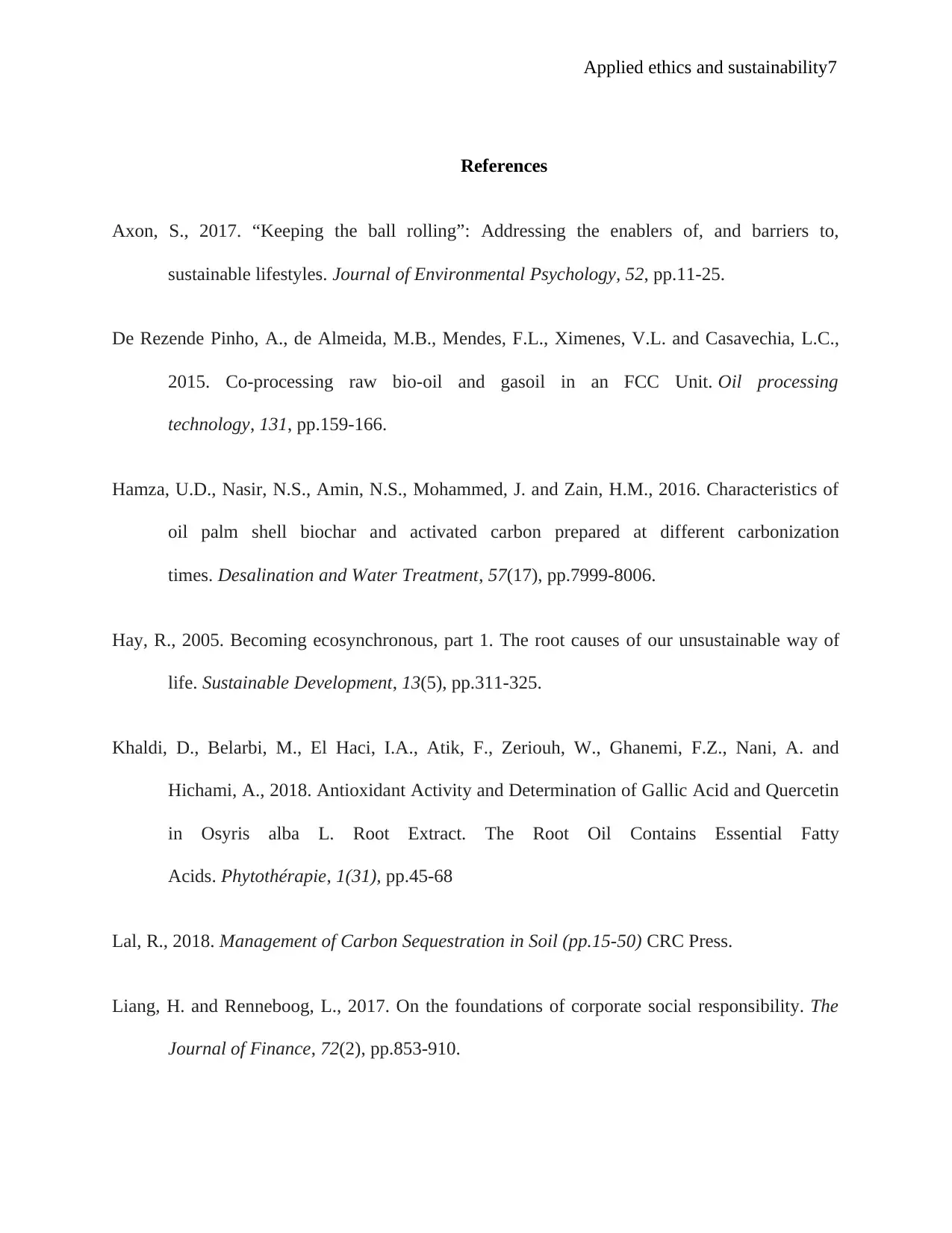
Applied ethics and sustainability7
References
Axon, S., 2017. “Keeping the ball rolling”: Addressing the enablers of, and barriers to,
sustainable lifestyles. Journal of Environmental Psychology, 52, pp.11-25.
De Rezende Pinho, A., de Almeida, M.B., Mendes, F.L., Ximenes, V.L. and Casavechia, L.C.,
2015. Co-processing raw bio-oil and gasoil in an FCC Unit. Oil processing
technology, 131, pp.159-166.
Hamza, U.D., Nasir, N.S., Amin, N.S., Mohammed, J. and Zain, H.M., 2016. Characteristics of
oil palm shell biochar and activated carbon prepared at different carbonization
times. Desalination and Water Treatment, 57(17), pp.7999-8006.
Hay, R., 2005. Becoming ecosynchronous, part 1. The root causes of our unsustainable way of
life. Sustainable Development, 13(5), pp.311-325.
Khaldi, D., Belarbi, M., El Haci, I.A., Atik, F., Zeriouh, W., Ghanemi, F.Z., Nani, A. and
Hichami, A., 2018. Antioxidant Activity and Determination of Gallic Acid and Quercetin
in Osyris alba L. Root Extract. The Root Oil Contains Essential Fatty
Acids. Phytothérapie, 1(31), pp.45-68
Lal, R., 2018. Management of Carbon Sequestration in Soil (pp.15-50) CRC Press.
Liang, H. and Renneboog, L., 2017. On the foundations of corporate social responsibility. The
Journal of Finance, 72(2), pp.853-910.
References
Axon, S., 2017. “Keeping the ball rolling”: Addressing the enablers of, and barriers to,
sustainable lifestyles. Journal of Environmental Psychology, 52, pp.11-25.
De Rezende Pinho, A., de Almeida, M.B., Mendes, F.L., Ximenes, V.L. and Casavechia, L.C.,
2015. Co-processing raw bio-oil and gasoil in an FCC Unit. Oil processing
technology, 131, pp.159-166.
Hamza, U.D., Nasir, N.S., Amin, N.S., Mohammed, J. and Zain, H.M., 2016. Characteristics of
oil palm shell biochar and activated carbon prepared at different carbonization
times. Desalination and Water Treatment, 57(17), pp.7999-8006.
Hay, R., 2005. Becoming ecosynchronous, part 1. The root causes of our unsustainable way of
life. Sustainable Development, 13(5), pp.311-325.
Khaldi, D., Belarbi, M., El Haci, I.A., Atik, F., Zeriouh, W., Ghanemi, F.Z., Nani, A. and
Hichami, A., 2018. Antioxidant Activity and Determination of Gallic Acid and Quercetin
in Osyris alba L. Root Extract. The Root Oil Contains Essential Fatty
Acids. Phytothérapie, 1(31), pp.45-68
Lal, R., 2018. Management of Carbon Sequestration in Soil (pp.15-50) CRC Press.
Liang, H. and Renneboog, L., 2017. On the foundations of corporate social responsibility. The
Journal of Finance, 72(2), pp.853-910.
Paraphrase This Document
Need a fresh take? Get an instant paraphrase of this document with our AI Paraphraser
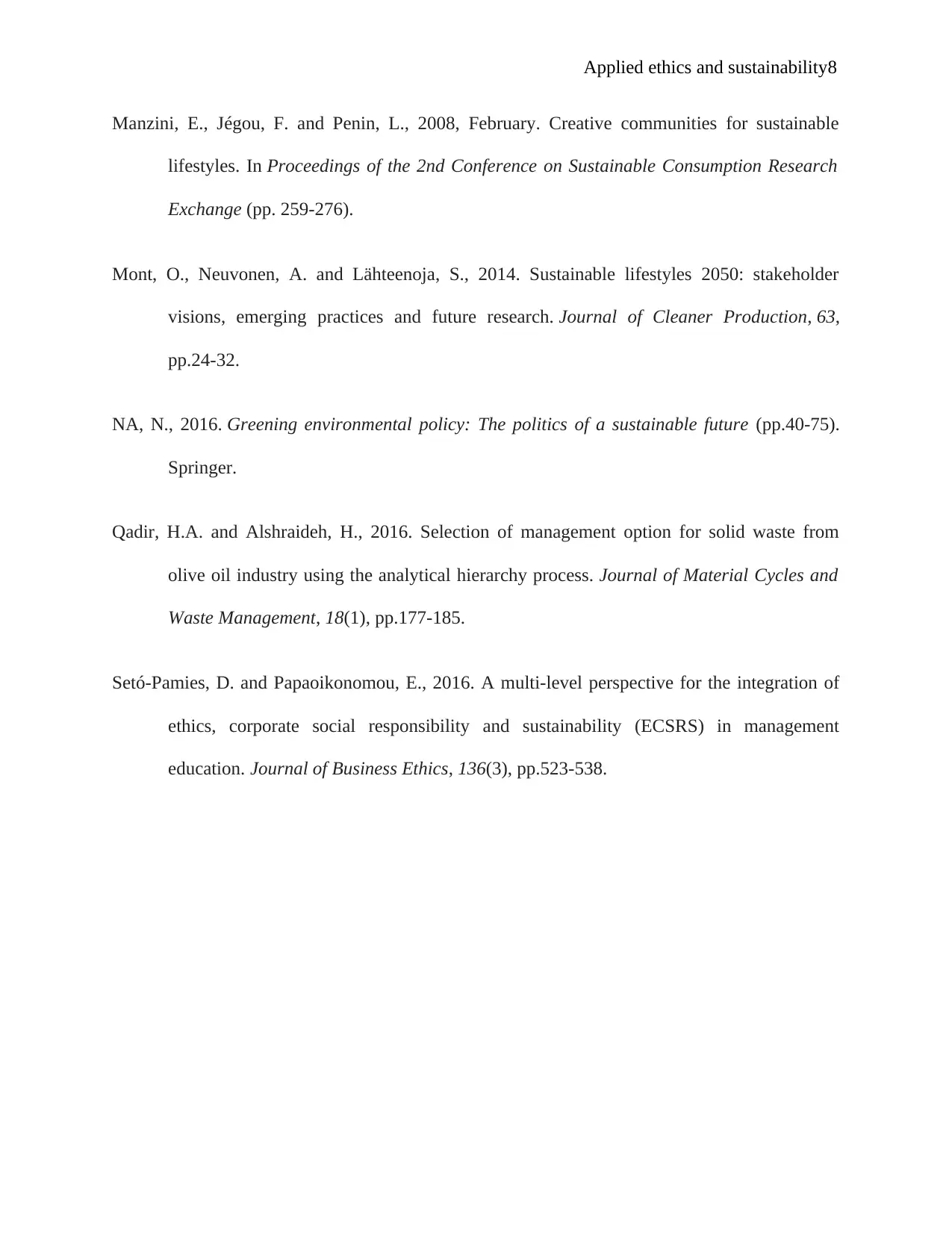
Applied ethics and sustainability8
Manzini, E., Jégou, F. and Penin, L., 2008, February. Creative communities for sustainable
lifestyles. In Proceedings of the 2nd Conference on Sustainable Consumption Research
Exchange (pp. 259-276).
Mont, O., Neuvonen, A. and Lähteenoja, S., 2014. Sustainable lifestyles 2050: stakeholder
visions, emerging practices and future research. Journal of Cleaner Production, 63,
pp.24-32.
NA, N., 2016. Greening environmental policy: The politics of a sustainable future (pp.40-75).
Springer.
Qadir, H.A. and Alshraideh, H., 2016. Selection of management option for solid waste from
olive oil industry using the analytical hierarchy process. Journal of Material Cycles and
Waste Management, 18(1), pp.177-185.
Setó-Pamies, D. and Papaoikonomou, E., 2016. A multi-level perspective for the integration of
ethics, corporate social responsibility and sustainability (ECSRS) in management
education. Journal of Business Ethics, 136(3), pp.523-538.
Manzini, E., Jégou, F. and Penin, L., 2008, February. Creative communities for sustainable
lifestyles. In Proceedings of the 2nd Conference on Sustainable Consumption Research
Exchange (pp. 259-276).
Mont, O., Neuvonen, A. and Lähteenoja, S., 2014. Sustainable lifestyles 2050: stakeholder
visions, emerging practices and future research. Journal of Cleaner Production, 63,
pp.24-32.
NA, N., 2016. Greening environmental policy: The politics of a sustainable future (pp.40-75).
Springer.
Qadir, H.A. and Alshraideh, H., 2016. Selection of management option for solid waste from
olive oil industry using the analytical hierarchy process. Journal of Material Cycles and
Waste Management, 18(1), pp.177-185.
Setó-Pamies, D. and Papaoikonomou, E., 2016. A multi-level perspective for the integration of
ethics, corporate social responsibility and sustainability (ECSRS) in management
education. Journal of Business Ethics, 136(3), pp.523-538.
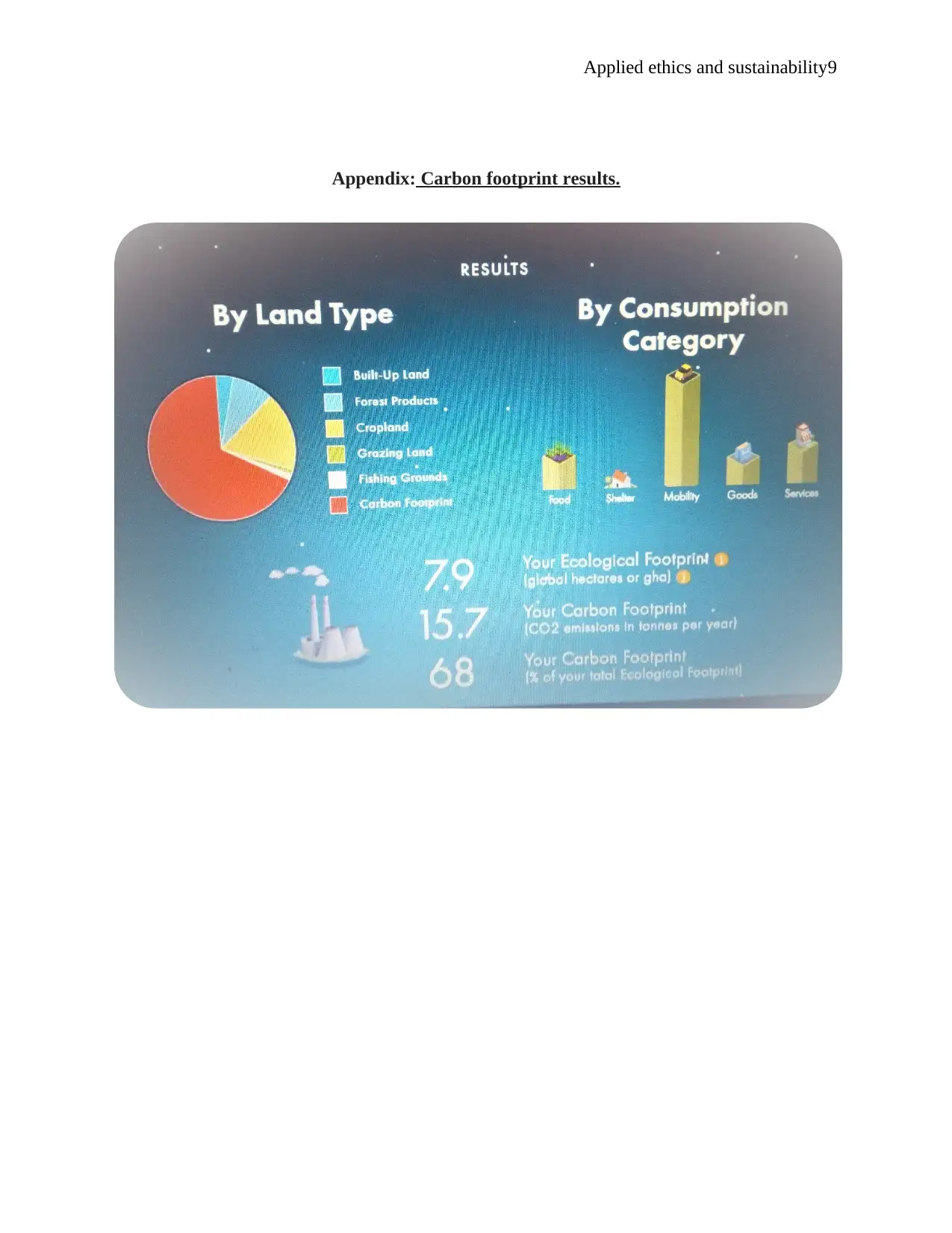
Applied ethics and sustainability9
Appendix: Carbon footprint results.
Appendix: Carbon footprint results.
⊘ This is a preview!⊘
Do you want full access?
Subscribe today to unlock all pages.

Trusted by 1+ million students worldwide
1 out of 9
Your All-in-One AI-Powered Toolkit for Academic Success.
+13062052269
info@desklib.com
Available 24*7 on WhatsApp / Email
![[object Object]](/_next/static/media/star-bottom.7253800d.svg)
Unlock your academic potential
Copyright © 2020–2025 A2Z Services. All Rights Reserved. Developed and managed by ZUCOL.


